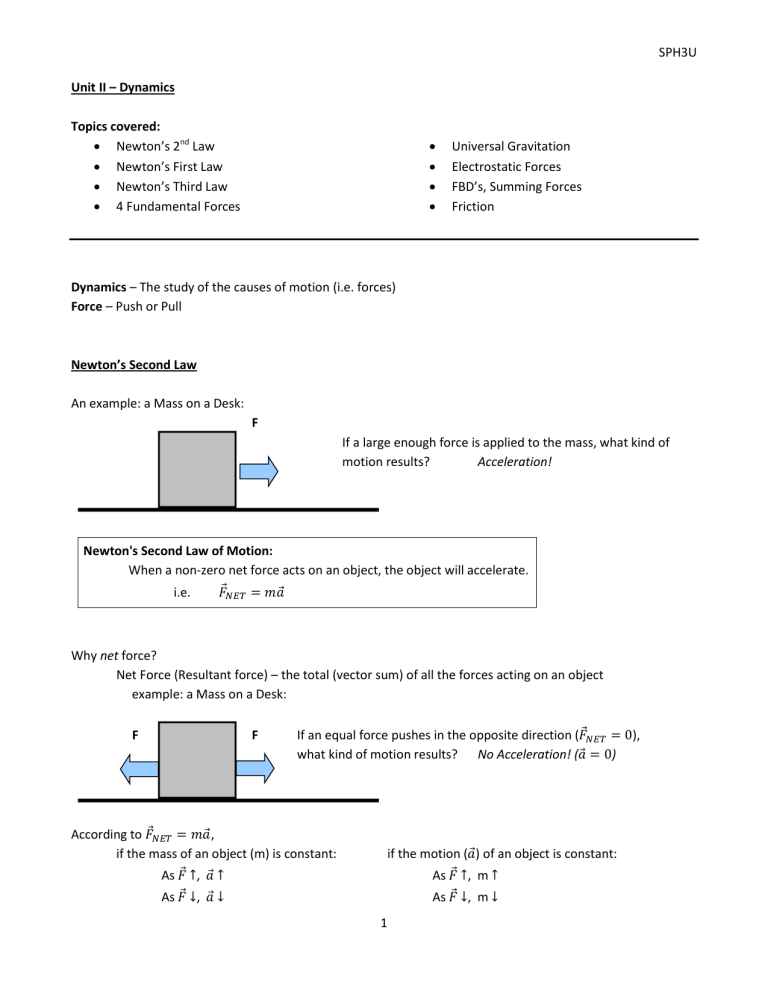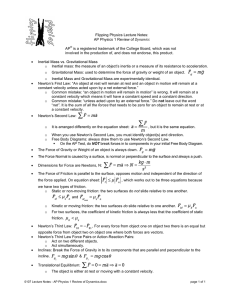
SPH3U Unit II – Dynamics Topics covered: Newton’s 2nd Law Newton’s First Law Newton’s Third Law 4 Fundamental Forces Universal Gravitation Electrostatic Forces FBD’s, Summing Forces Friction Dynamics – The study of the causes of motion (i.e. forces) Force – Push or Pull Newton’s Second Law An example: a Mass on a Desk: F If a large enough force is applied to the mass, what kind of motion results? Acceleration! Newton's Second Law of Motion: When a non-zero net force acts on an object, the object will accelerate. i.e. 𝐹⃗𝑁𝐸𝑇 𝑚𝑎⃗ Why net force? Net Force (Resultant force) – the total (vector sum) of all the forces acting on an object example: a Mass on a Desk: F F If an equal force pushes in the opposite direction ( ⃗ what kind of motion results? No Acceleration! ( ⃗ According to ⃗ ⃗, if the mass of an object (m) is constant: As ⃗ ↑, ⃗ ↑ ), ) if the motion ( ⃗) of an object is constant: As ⃗ ↑, m ↑ As ⃗ ↓, ⃗ ↓ As ⃗ ↓, m ↓ 1 SPH3U Units of Force: The unit of force is the Newton, N. 1 N = 1 kg m/s 2 (from Newton's Second Law) Since forces are vectors, they require directions [ ] e.g. ⃗ the force in the box was 55.5 N [E] Newton’s First Law of Motion: The Law of Inertia Galileo’s Thought Experiment: Ignoring friction, a ball rolling down one side of the ramp will roll up the other side of the ramp to the same height. If the second ramp were extended and its slope reduced, the ball will still reach the same height, but travel further to do so (since the ramp is easier to ascend). If the second ramp were lowered such that it became horizontal, the ball should move forever, forever trying to get back to its original height. Newton's First Law of Motion: If the net force acting on an object is zero, the object will maintain its current state of motion (at rest or with a constant velocity). What does this mean? objects at rest tend to remain at rest objects in motion tend to remain in motion if the velocity of an object is constant, the net external force must be zero if the object is accelerating, it must be caused by a non-zero net external force Inertia - the 'tendency' of objects to remain in their current state of motion was called inertia by Sir Isaac Newton. The more inertia an object has, the more likely it will remain in its current state of motion (and, by extension, the more force will be required to change its current state of motion). e.g. while riding in a moving car with no seatbelt, if the car stops (i.e. crashes) you continue to move forward (i.e. through the windshield). 2 SPH3U Newton’s Third Law of Motion - The Action-Reaction Law Newton's Third Law of Motion: For every action force there exists is a reaction force equal in magnitude and opposite in direction. ** Action / reaction forces act on different objects** Action-Reaction Pairs: For every force that is exerted, two separate objects experience it. Action-reaction pairs identify the relationship between the force and each object. Example: Apple hanging on tree Forces acting on apple: gravity (Fg), applied force from stem (FStem) Forces Acting on Apple FStem Action-Reaction Pairs FStem stem pulls upwards on apple apple pulls downwards on stem Fg earth pulls down on apple apple pulls up on earth! Fg Fundamental Forces of Nature Force Relative Strength (approx.) Range Effect strong nuclear 1038 less than 10-15 m attraction and repulsion weak nuclear 1025 less than 10-18 m attraction and repulsion gravitation 1 ∞ attraction only electromagnetic 1036 ∞ attraction and repulsion Strong Nuclear Force The force that holds protons and neutrons together in the nucleus (protons repel!). This force is stronger than the electromagnetic force, but it is extremely short-ranged. Weak Nuclear Force The force responsible for elementary particle (protons, neutrons, etc) interactions, such as radioactivity. 3 SPH3U (Universal) Gravitation The mutual force of attraction between any two objects that have mass. The magnitude of this force depends only on the masses of the two objects and the distance between them. Electromagnetic Force The force caused by charged particles, which includes both electric and magnetic forces. Most common forces are actually electromagnetic forces, when sufficiently analysed. Universal Gravitation Newton’s Law of Universal Gravitation: The force of gravitational attraction between any two objects is directly proportional to the product of the masses of the objects, and inversely proportional to the square of the distance between the objects. OR, 𝐺𝑚 𝑚2 𝐹⃗𝑔 𝑟2 A gravitational force exists between all objects in the universe, no matter their mass or how far away they might be. The force with which one object pulls on a second object is the same in magnitude but opposite in direction to the force of the second object on the first (Newton's 3rd Law). Gravitational forces are extremely weak, since the gravitational constant, G, is so tiny. Universal Gravitational Constant (big 'G') Universal gravitational constant, G = 6.67x10-11 Nm2/kg2 G was calculated by Newton, but verified experimentally over 100 years later by Henry Cavendish. Knowing G enabled us to accurately determine the mass of the earth and other heavenly bodies. Gravitational Field Strength Force Field: space surrounding an object in which the object exerts a force on other objects in that space Gravitational field strength: force per unit mass ⃗ gravitational field strength of mass m1. The symbol we give for the gravitational field strength of an object is ⃗ (little ‘g’). We can now simplify the equation of universal gravitation if we know the gravitational field strength of an object: ⃗ ⃗ Every object in the universe has a gravitational field, and its strength only depends on its mass and how far another object is from it (i.e. the further away a 'test' object from the object producing the field is, the weaker the force of attraction. Due to the relationship, this gravitational force quickly diminishes with distance). 4 SPH3U Gravity and Outer Space Sometimes astronauts are said to experience 'weightlessness' or 'microgravity'. Both of these terms can be misleading: The force of gravity still exists in outer space, and of course only depends on the astronauts' mass and how far from the earth they are, and so therefore astronauts still have weight (though, when in orbit, if a scale is placed under an astronaut, it would read 0 N, since both the astronaut and scale are in free fall - more on this in grade 12). Gravity is never zero - according to the equation above, the only time the force of gravity is zero is when you are infinitely far away. It can be extremely small, but never zero. Weight When we ask someone how, much they weigh, the answers we get do not match what we are really asking for: “How much do you weigh?” “Oh, about 65 kg (145 lbs)” In physics, weight is the total force an object exerts on the ground due to gravity. If you ask for a person’s weight, they should respond in Newtons, not kilograms (which is mass) mass: quantity of matter in an object. weight: the force of gravity on an object. (measured in kilograms, kg) (measured in Newtons, N) Force of Gravity, Due to the Earth, Near the Earth's Surface If we use the mass and radius of the earth, we can determine the gravitational field strength of the earth at its surface: ⃗ ⃗ ⃗ ( ⁄ )( ( ⁄ ) ) 2 !!!!! Of course!! Our theory of gravity must match reality, and indeed the value for the acceleration of any object falling near the surface of the earth measured by Galilieo, many years previous, matched that which was predicted in Newton’s mathematics! Galileo had only discovered a special case for general (universal) law of gravity: near the surface of the earth, whereas Newton’s description whorls every where and for everything! 5 SPH3U Types of (macroscopic) Electromagnetic Forces Type of Force Symbol Description Useful Info Example Applied Force Fapp Any general contact its symbol can depend on the force object providing the force (i.e. Fengine, Fgirl, Ffinger, etc.) Normal FN Forces applied by surfaces The direction of this force is always A refrigerator on the floor perpendicular to the surface Tension FT Forces applied by ropes, strings, etc Only pulls (“Can’t push a rope”) Friction Ff* Any force that opposes motion The direction of this force is always in opposite direction of motion Static Friction forces that prevent stationary objects from moving Fkinetic < Fstatic Kinetic friction forces that oppose the motion of moving objects Static and kinetic friction do not the floor resisting the motion have their own symbols, one must of a refrigerator as it moves know which is appropriate for a given situation. * A human pushing a refrigerator Pulling a refrigerator with a rope the floor preventing the movement of a large refrigerator when an applied force is used friction caused by air is usually written as Fair Free Body Diagrams (FBD’s), Summing Forces Draw a circle/box to represent the object. Draw forces as vectors (arrows) originating from the centre of the box/circle, pointing away. The direction of the vectors must match the direction of the forces example: Mathematically Analyzing Motion Separate forces into those that exist in the 'y' direction and those that exist in the 'x' direction. Add the forces (remember they are vectors!) the find the net force in each the 'y' and 'x' directions, using the following format: ΣFx = F1x + F2x + F3x + ... ΣFy = F1y + F2y + F3y + ... Apply these net forces to Newton's second law: ΣFx = F1x + F2x + F3x + ... = max ΣFy = F1y + F2y + F3y + ... = may 6 SPH3U example: ΣFx = Fapp + Ff = max ΣFy = FN + Fg = may = 0 Effects of Friction Friction exists whenever two surfaces are in contact. The amount of friction depends on the characteristics of each surface, and so, is different for every combination of surfaces (i.e. rubber and dry asphalt, rubber and wet asphalt, etc). The measure of how much friction exists between two surfaces is the coefficient of friction, μ Coefficient of Friction ( μ ) A number ratio between the magnitude of the frictional force, Ff , and the magnitude of the normal force FN, such that: or, |⃗ | |⃗ | Gives us an idea of the amount of friction present: the higher the value, the more friction exists Coefficients of friction can only be determined experimentally. Rearranging the equation, we can determine frictional forces: Ff = μFN Types of Friction: Static and Kinetic Static: Force that prevents a stationary object from moving Kinetic: Force that acts against an object’s motion in a direction opposite the motion. Types of kinetic: Rolling friction, sliding friction, fluid friction, etc. Fkinetic < Fstatic Coefficients of friction, for a given pair of surfaces, will change depending on whether they are moving or stationary relative to each other, so we have: What Causes Friction? Since friction is actually an electromagnetic force, it is caused by chemical bonding between the moving surfaces; it is caused by stickiness. When the surfaces are moving, it is best described by "stick & slip" processes. When thinking about friction, don't think about grains of sand on sandpaper. Instead think about sticky adhesive tape being dragged along a surface. Friction is not to be confused with traction, as friction (chemical bonding processes between surfaces) is independent of surface area, whereas traction does (along with several other factors). 7

